Are you a Quiet Speculation member?
If not, now is a perfect time to join up! Our powerful tools, breaking-news analysis, and exclusive Discord channel will make sure you stay up to date and ahead of the curve.
The paper Prerelease and the digital release of Innistrad: Midnight Hunt is this weekend. Subsequently, the entire set has been spoiled. In turn, this means that I can evaluate the remaining cards with better context. And there's... mixed news. IMH has some gems for Modern, but it's mostly misses. Which isn't a bad thing after MH2. And even among those potential Modern playables, there are a lot of questions to answer.
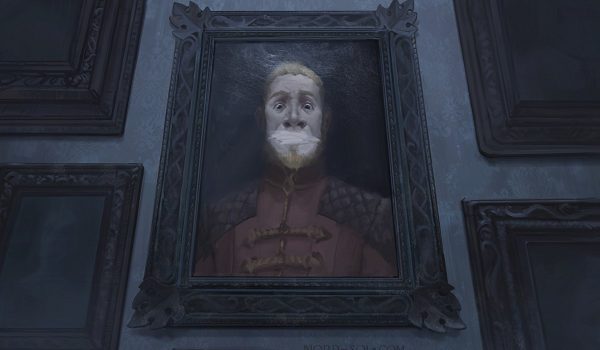
As anticipated, the set is quite powered down. It's not just in Modern terms, but Standard too. Given the past few years, I'd argue that's a good thing. However, I don't play Standard much and actual Standard experts may disagree. What is inarguable is that the most Modern-playable card was among the first spoiled. Nothing has come close to Consider's potential for widespread adoption. There isn't much that rivals it in power terms, for that matter. However, a few cards have obvious homes but fulfil a specialized role. They have a specific job to do, do it well, but it may not need to be done often. In many other cases the stars and moon will need to align for the card to be useful despite innate playability.
Sideboard Smorgasbord
After Consider, the cards that are most likely to see Modern play are the sideboard cards spoiled between my previous article and now. They're not inherently more powerful, unique, or needed than any of the other cards in IMH. Rather, sideboard cards can be fairly niche and see play in small numbers in more decks than a maindeck card. And the IMH prospects are particularly flexible which suggests that many decks can play them. The question isn't whether they're good enough for sideboard play, it's whether they solve an actual problem in the metagame. And some definitely do.
Helping Humans
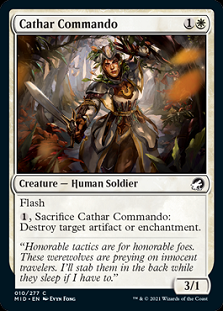 Specifically, Cathar Commando and Outland Liberator fill well-known holes for several decks and will be adopted by at least some sideboards. See, the biggest hole in Humans has always been its weakness against Torpor Orb. The deck is built around creatures with enters-the-battlefield triggers, and Champion of the Parish is unplayably bad under the Orb. This weakness is compounded by Humans lacking Qasali Pridemage in-tribe. Humans can go outside the tribe for some answers, but Pridemage's cost was prohibitive due to its creature types. All the other options were similarly answered by Orb. Humans finally has two options to defeat the Orb or any other prison piece it needs to.
Specifically, Cathar Commando and Outland Liberator fill well-known holes for several decks and will be adopted by at least some sideboards. See, the biggest hole in Humans has always been its weakness against Torpor Orb. The deck is built around creatures with enters-the-battlefield triggers, and Champion of the Parish is unplayably bad under the Orb. This weakness is compounded by Humans lacking Qasali Pridemage in-tribe. Humans can go outside the tribe for some answers, but Pridemage's cost was prohibitive due to its creature types. All the other options were similarly answered by Orb. Humans finally has two options to defeat the Orb or any other prison piece it needs to.
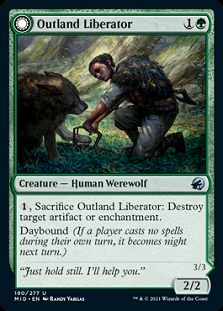 Liberator's front face is worse than Commando's mainly because flash is so powerful (an extra point of power never hurts, though). However, the potential of flipping Liberator into Frenzied Trapbreaker makes up for that weakness to the point that I'd expect Humans to adopt Liberator over Commando. True, Trapbreaker doesn't synergize with Humans, but it doesn't need to itself. Liberator has that covered and any +1/+1 counters will carry over when flipped. It's one thing to Pridemage
Liberator's front face is worse than Commando's mainly because flash is so powerful (an extra point of power never hurts, though). However, the potential of flipping Liberator into Frenzied Trapbreaker makes up for that weakness to the point that I'd expect Humans to adopt Liberator over Commando. True, Trapbreaker doesn't synergize with Humans, but it doesn't need to itself. Liberator has that covered and any +1/+1 counters will carry over when flipped. It's one thing to Pridemage 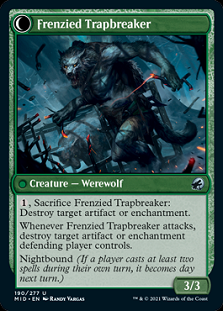 away a threat; it's another to be able to swing into Urza's Saga constructs with confidence. Also worth noting: Saga itself is a target. Liberator even makes Gavony Dawnguard more playable by getting Day/Night tracking started.
away a threat; it's another to be able to swing into Urza's Saga constructs with confidence. Also worth noting: Saga itself is a target. Liberator even makes Gavony Dawnguard more playable by getting Day/Night tracking started.
Commando probably won't make the cut for Humans, but that doesn't mean it won't at all. Death and Taxes has a similar hole that I've pointed out before and Commando fills it nicely. Stoneblade may also spring for Commando mostly because it's a two mana flash threat. That deck needs to establish a clock against slow decks, and Commando does that cheaply with upside.
The Hermit's Grudge
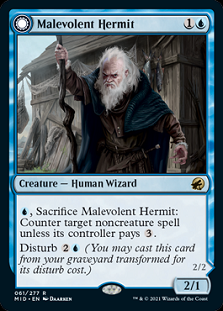 The next two are far more speculative, but I can definitely see their niche. Typically, control mirrors devolve into staring competitions followed by a frenzy of activity as one deck goes for it. Malevolent Hermit offers a pretty solid way to reposition and possibly steal games 2 and 3. A 2/1 beater isn't anything special, but Hermit's front face does provide a better Spell Pierce which stays active under Teferi, Time Raveler. And also can't be countered by Force of Negation. That's a pretty great way to pressure opponents/planeswalkers and keep up the shields.
The next two are far more speculative, but I can definitely see their niche. Typically, control mirrors devolve into staring competitions followed by a frenzy of activity as one deck goes for it. Malevolent Hermit offers a pretty solid way to reposition and possibly steal games 2 and 3. A 2/1 beater isn't anything special, but Hermit's front face does provide a better Spell Pierce which stays active under Teferi, Time Raveler. And also can't be countered by Force of Negation. That's a pretty great way to pressure opponents/planeswalkers and keep up the shields.
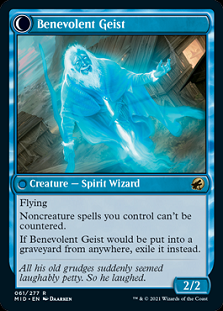 However, it's the back side that can run away with games. Having a creature that can return from the graveyard is solid as it's card advantage. A flying creature that moots opposing counterspells is better. The only problem with Benevolent Geist is actually getting it into play. Casting it is no different than going for Teferi, but Geist can only be cast from the graveyard. This means that Hermit has to be cashed in first, which is no bad thing, or killed. The problem with the later option: most control removal exiles. However, that does leave the door open for looting effects if rushing to Geist is a thing. In either case, control players should be aware of the Hermit's power.
However, it's the back side that can run away with games. Having a creature that can return from the graveyard is solid as it's card advantage. A flying creature that moots opposing counterspells is better. The only problem with Benevolent Geist is actually getting it into play. Casting it is no different than going for Teferi, but Geist can only be cast from the graveyard. This means that Hermit has to be cashed in first, which is no bad thing, or killed. The problem with the later option: most control removal exiles. However, that does leave the door open for looting effects if rushing to Geist is a thing. In either case, control players should be aware of the Hermit's power.
Fighting Combo
On a similar thread, Curse of Silence is quite the card. Adding cost onto the key card in an opponent's deck is potentially devastating. And as a benefit, should the opponent manage to overcome the tax and cast the card, the Curse can be cashed in to try for an answer. That's a lot of value for 1 mana, and virtually ensures that Curse will see play. Especially because it's a one-sided effect, with its being a Curse.
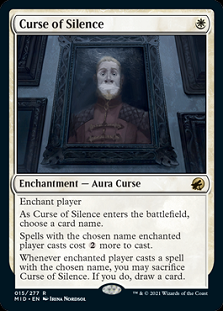 This has led a lot of players to point to Curse as the answer to Crashing Footfalls and Living End. And they're not wrong; delaying either deck's main gameplan until turn 5 is quite strong. However, the catch is that both decks have ways to answer the enchantment and still go off turn 3, with Brazen Borrower being the most common. This does not disqualify Curse as a sideboard card, but it does mean that it needs support to be effective. I'd argue that since Curse only delays the named card, it's not a general answer, but a taxing card, and that would limit play to tempo and aggro decks that actually put the delay to good use.
This has led a lot of players to point to Curse as the answer to Crashing Footfalls and Living End. And they're not wrong; delaying either deck's main gameplan until turn 5 is quite strong. However, the catch is that both decks have ways to answer the enchantment and still go off turn 3, with Brazen Borrower being the most common. This does not disqualify Curse as a sideboard card, but it does mean that it needs support to be effective. I'd argue that since Curse only delays the named card, it's not a general answer, but a taxing card, and that would limit play to tempo and aggro decks that actually put the delay to good use.
However, I think that pigeonholing Curse as an anti-combo card is shortsighted. Curse can hit any card type, and so control can use it turns 1-2 to slow down creature rushes. Aggro can use it to keep sweepers at bay. And combo can also use it to protect against answers. Curse is so flexible that I can see any deck with white using it, and maybe even maindecking it. Don't sleep on this card.
The Tricky One
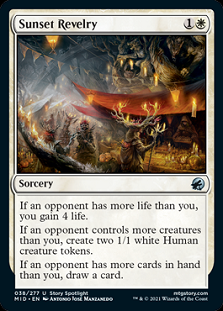 The final card is tricky to evaluate. It has one clear home, but that home is already occupied. Sunset Revelry is a cheaper Timely Reinforcements with a bonus. For one less mana it makes one less token and gains two less life. There's also a third clause that's unlikely to be relevant for a control deck against Burn, which is where Timely sees play. Being cheaper is usually the best way to see play and that's led to speculation that Revelry has made Timely obsolete. I'd be more cautious.
The final card is tricky to evaluate. It has one clear home, but that home is already occupied. Sunset Revelry is a cheaper Timely Reinforcements with a bonus. For one less mana it makes one less token and gains two less life. There's also a third clause that's unlikely to be relevant for a control deck against Burn, which is where Timely sees play. Being cheaper is usually the best way to see play and that's led to speculation that Revelry has made Timely obsolete. I'd be more cautious.
Timely is more costly, but it's worth it. For three mana, Timely trades with Goblin Guide and two Lightning Bolts and blocks another creature. Or trades with two attacks from a 3/3 and kills that 3/3. That's an enormous swing for one card. Revelry still trades with Guide, but it only trades for one and a third Bolts and can't kill an X/3. That's actually a considerable step down from Timely. And if the third clause (which would make up for everything else) triggers, then something's going very wrong in that game and control is either doomed anyway or in no real danger.
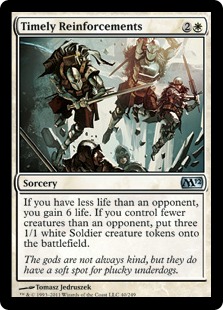 However, that cantrip potential might open up more space for Revelry. Timely never sees play outside of control vs aggro, but I could see Revelry being played by aggro against aggro. Being on the draw is quite hard for any creature deck, and getting on the back foot early can be fatal. Revelry can help a stalling aggro deck get back in against a better board. 4 life and 2 humans isn't going to do that, but those things plus a cantrip might. The latter is the most important part since it digs for more threats and may actually be valuable against midrange for that reason. That Tarmogoyf will hold off the humans perfectly fine, but I'm getting another chance to hit a real threat and you'll have to keep the 'Goyf back a turn or two. I'll certainly be testing it.
However, that cantrip potential might open up more space for Revelry. Timely never sees play outside of control vs aggro, but I could see Revelry being played by aggro against aggro. Being on the draw is quite hard for any creature deck, and getting on the back foot early can be fatal. Revelry can help a stalling aggro deck get back in against a better board. 4 life and 2 humans isn't going to do that, but those things plus a cantrip might. The latter is the most important part since it digs for more threats and may actually be valuable against midrange for that reason. That Tarmogoyf will hold off the humans perfectly fine, but I'm getting another chance to hit a real threat and you'll have to keep the 'Goyf back a turn or two. I'll certainly be testing it.
Maindeck Cards Looking for a Home
There are also card that could make it in maindecks. However, there are a lot more questions there. In most cases the question is the same: "Why play this over an existing option?" However, there are two cards that would be perfect for a deck which doesn't currently exist. And I'm not sure that deck could exist in Modern.
Solid Cards with Stiff Competition
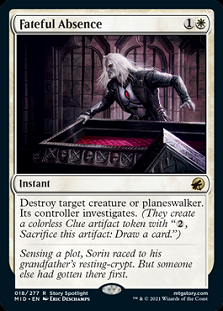 Just like Portable Hole, Fateful Absence would be a playable card were it not for Prismatic Ending. White has been hurting for this effect for a long time and turning Wrenn and Six or Teferi (any of him) into a clue is a very good deal. Destroying creatures is a bonus compared to killing 'walkers. However, the only reason to play Absence is that Ending isn't an option. That means mono-white, and this isn't an effect that DnT is looking for. However, in the right metagame, I could see it happening. Also worth noting you can hit your own creatures if they're about to die to removal or get stolen.
Just like Portable Hole, Fateful Absence would be a playable card were it not for Prismatic Ending. White has been hurting for this effect for a long time and turning Wrenn and Six or Teferi (any of him) into a clue is a very good deal. Destroying creatures is a bonus compared to killing 'walkers. However, the only reason to play Absence is that Ending isn't an option. That means mono-white, and this isn't an effect that DnT is looking for. However, in the right metagame, I could see it happening. Also worth noting you can hit your own creatures if they're about to die to removal or get stolen.
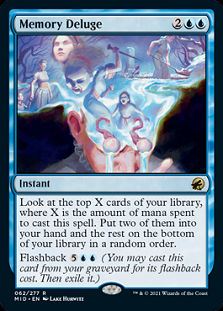 Similarly, Memory Deluge is a good card that I don't think is good enough. Picking the best two cards from the top four is decent and such digging and selection is especially important for control and combo decks. Four mana is a steep enough price that I think Deluge would be limited to control. The problem is that for less colored mana, Fact or Fiction digs five cards deep. Anyone who's played with or against Fact knows that the caster always gets what they want, so that's not a knock compared to Deluge. The big attraction is the flashback which makes Deluge Dig Through Time with minor discount and no delve. Of course, paying full price for Dig limits it to the late game, and considering that Fact isn't really seeing play, I don't think Deluge has a chance.
Similarly, Memory Deluge is a good card that I don't think is good enough. Picking the best two cards from the top four is decent and such digging and selection is especially important for control and combo decks. Four mana is a steep enough price that I think Deluge would be limited to control. The problem is that for less colored mana, Fact or Fiction digs five cards deep. Anyone who's played with or against Fact knows that the caster always gets what they want, so that's not a knock compared to Deluge. The big attraction is the flashback which makes Deluge Dig Through Time with minor discount and no delve. Of course, paying full price for Dig limits it to the late game, and considering that Fact isn't really seeing play, I don't think Deluge has a chance.
The Build-Arounds
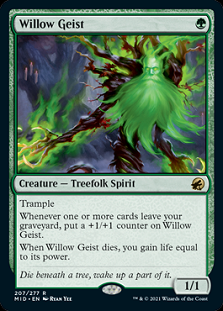 I want to acknowledge Willow Geist as a great build-around card. It can grow impressively large alongside Wrenn and Six, Lurrus of the Dream-Den, and to a lesser extent Murktide Regent. However, I have no idea if that's something viable in practice or what such a deck might look like, so I'm leaving Geist to Jordan if he wants it.
I want to acknowledge Willow Geist as a great build-around card. It can grow impressively large alongside Wrenn and Six, Lurrus of the Dream-Den, and to a lesser extent Murktide Regent. However, I have no idea if that's something viable in practice or what such a deck might look like, so I'm leaving Geist to Jordan if he wants it.
More Phoenix Enablers?
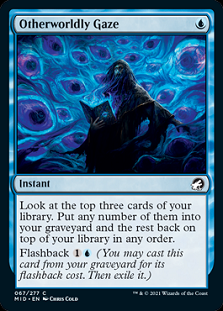 Meanwhile, there are a couple more enablers being suggested for graveyard decks. Phoenix primarily, again. Otherworldly Gaze is the main one, as filtering the top three cards and filling the graveyard on turn one is a decent way to set up Phoenix. However, everything I said about Faithful Mending applies here. On top of all that, Gaze isn't a cantrip, and that means it contributes to Phoenix's engine slowing down. That's not ideal. It's also been suggested that Millvine or Dredge could make use of Gaze, but those decks already have Stitcher's Supplier and Gaze isn't enough better than Supplier to make the stretch.
Meanwhile, there are a couple more enablers being suggested for graveyard decks. Phoenix primarily, again. Otherworldly Gaze is the main one, as filtering the top three cards and filling the graveyard on turn one is a decent way to set up Phoenix. However, everything I said about Faithful Mending applies here. On top of all that, Gaze isn't a cantrip, and that means it contributes to Phoenix's engine slowing down. That's not ideal. It's also been suggested that Millvine or Dredge could make use of Gaze, but those decks already have Stitcher's Supplier and Gaze isn't enough better than Supplier to make the stretch.
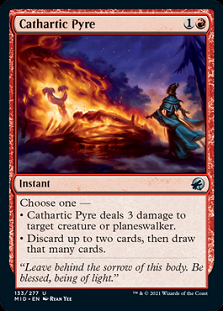 Cathartic Pyre also sees discussion. The flexibility of a removal or rummage spell in Phoenix or Dredge is certainly attractive. However, again, why would either bother? Phoenix has lots of more efficient removal already and Dredge doesn't need any. At two mana, Cathartic Reunion is far more powerful. It could be an Abrade situation, but then the question becomes, is there chaff to cut?
Cathartic Pyre also sees discussion. The flexibility of a removal or rummage spell in Phoenix or Dredge is certainly attractive. However, again, why would either bother? Phoenix has lots of more efficient removal already and Dredge doesn't need any. At two mana, Cathartic Reunion is far more powerful. It could be an Abrade situation, but then the question becomes, is there chaff to cut?
Perfect for a Non-Existent Deck
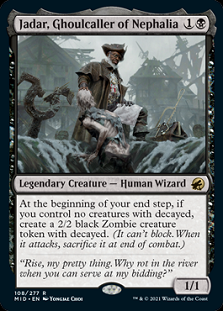 Finally, there are two cards that would be very playable in a deck that does not and maybe cannot exist in Modern. The zombie tokens in IMH have decayed, which makes the fairly useless except as bad Shocks. As a trade-off, they can be made more efficiently than normal, reusable Zombies. Maro confirmed that Wizards wants them either to be stockpiled for one massive attack or used a fodder for sacrifice effects. The former is way too slow for Modern, but the latter might be viable. Aristocrats decks have been tried plenty in the past so maybe there's something out there which requires a constant stream of zombies.
Finally, there are two cards that would be very playable in a deck that does not and maybe cannot exist in Modern. The zombie tokens in IMH have decayed, which makes the fairly useless except as bad Shocks. As a trade-off, they can be made more efficiently than normal, reusable Zombies. Maro confirmed that Wizards wants them either to be stockpiled for one massive attack or used a fodder for sacrifice effects. The former is way too slow for Modern, but the latter might be viable. Aristocrats decks have been tried plenty in the past so maybe there's something out there which requires a constant stream of zombies.
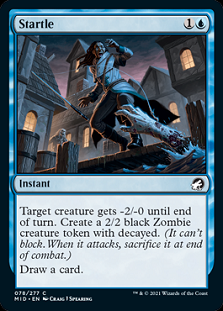 In that specific circumstance, Jadar, Ghoulcaller of Nephalia becomes a keystone card. Making a decayed zombie every end step is great when said Zombie is going to be fed to something every turn. In such a deck it would be trivial to trigger Jadar every endstep. He's as fragile as they come, but that also makes him something to feed to the engine and replace. However, the real standout in that deck would be Startle. Sacrifice engine decks tend to be a bit slow and vulnerable to aggro. Startle buys time and makes more fodder for the engine without costing a card. It's priced right for Modern, but again, without a hungry sacrifice engine the effect is too weak. If one exists, then we're talking.
In that specific circumstance, Jadar, Ghoulcaller of Nephalia becomes a keystone card. Making a decayed zombie every end step is great when said Zombie is going to be fed to something every turn. In such a deck it would be trivial to trigger Jadar every endstep. He's as fragile as they come, but that also makes him something to feed to the engine and replace. However, the real standout in that deck would be Startle. Sacrifice engine decks tend to be a bit slow and vulnerable to aggro. Startle buys time and makes more fodder for the engine without costing a card. It's priced right for Modern, but again, without a hungry sacrifice engine the effect is too weak. If one exists, then we're talking.
Now, Breathe
Alight, that's the end of Midnight Hunt. Everyone breathe out. Relax a minute. But only one. We only have a few weeks to brew around with these cards before Crimson Vow starts up. This year has just been a whirlwind, hasn't it?



